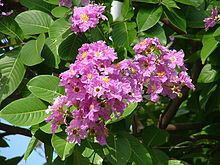bio.wikisort.org - Plant
Lagerstroemia speciosa (giant crepe-myrtle, Queen's crepe-myrtle, banabá plant, or pride of India[2]) is a species of Lagerstroemia native to tropical southern Asia. It is a deciduous tree with bright pink to light purple flowers.[3]
| Lagerstroemia speciosa | |
|---|---|
 | |
| Flowers on a tree in Kolkata, West Bengal, India | |
| Scientific classification | |
| Kingdom: | Plantae |
| Clade: | Tracheophytes |
| Clade: | Angiosperms |
| Clade: | Eudicots |
| Clade: | Rosids |
| Order: | Myrtales |
| Family: | Lythraceae |
| Genus: | Lagerstroemia |
| Species: | L. speciosa |
| Binomial name | |
| Lagerstroemia speciosa (L.) Pers. | |
| Synonyms[1] | |
| |
Etymology
The genus Lagerstroemia was first described by Carl Linnaeus. The name Lagerstroemia recognizes Magnus von Lagerstroem, a Swedish naturalist who provided specimens from the East for Linnaeus.
Names
- English : Pride of India, Queen Crepe Myrtle
- Bengali: জারুল (Jarul)
- Hindi: जरुल (Jarul)
- Indonesian: Bungur
- Kapampangan: Banába
- Marathi: ताम्हण (Tamhan), जारुळ (Jarul), मोठा बोंडारा (Motha Bondara)
- Assamese: এজাৰ (Ejār)
- Tagalog: Banaba
- Vietnamese: Bằng lăng nước
- Malayalam: മണിമരുത്,പൂമരുത്
- Thai: อินทนิล (Inthanin)
- Tamil :கதலி (மலர்)
- Malay: Bungor raya
Growth

It is a small to medium-sized tree growing to 20 metres (66 ft) tall, with smooth, flaky bark. The leaves are deciduous, oval to elliptic, 8–15 cm (3.1–5.9 in) long and 3–7 cm (1.2–2.8 in) broad, with an acute apex. The flowers are produced in erect panicles 20–40 cm (7.9–15.7 in) long, each flower with six white to purple petals 2–3.5 cm (0.79–1.38 in) long. The flowers in this plant blooms only once in a year at the peak of summer.
Cultivation and uses
This section needs additional citations for verification. (October 2011) |
It is grown in South East Asia, India, Bangladesh and the Philippines. It is also widely cultivated as an ornamental plant in tropical and subtropical areas. The leaves of the banabá and other parts are used widely in the Philippines, Taiwan, and Japan as a tea preparation. Banabá herb is one of the 69 herbal plants promoted by the Philippine Department of Health (DOH).[4] In Vietnam the plant's young leaves are consumed as vegetables, and its old leaves and mature fruit are used in traditional medicine for reducing glucose in blood.[5]
The seeds have narcotic properties.[6]
Chemistry
Chemical compounds that have been isolated from the extract include corosolic acid, lager-stroemin, flosin B, and reginin A.[7]
Recognition
Pride of India or Tāmhan in Marathi is recognised as the state flower of the state of Maharashtra in India.[8]
In Buddhism
In Theravada Buddhism, this plant is said to have been used as the tree for achieved enlightenment, or Bodhi by the eleventh Buddha ("Paduma – පදුම"), and the twelfth Buddha (Naarada – නාරද). The plant is known as මුරුත (Murutha) in Sinhala and Mahaasona – මහාසොණ in Sanskrit.
Gallery
- Fruit, leaves & black drongo (Kolkata, West Bengal, India)
- Flowers and leaves (Kolkata, West Bengal, India)
- Dried fruits (Kolkata, West Bengal, India)
- Dried fruits (Kolkata, West Bengal, India)
- Flowering small tree (Narsingdi, Bangladesh)
- Inflorescence close up (Camarines Sur, Philippines)
References
- Lagerstroemia speciosa (L.) Pers. — The Plant List
- "Lagerstroemia speciosa (L.) Pers. pride of India." PLANTS Profile, United States Department of Agriculture / Natural Resources Conservation Service. Retrieved 2008-07-15.
- "Lagerstroemia speciosa (Giant Crape Myrtle, Queen's Crape Myrtle) | North Carolina Extension Gardener Plant Toolbox". plants.ces.ncsu.edu. Retrieved 2021-11-01.
- Eduardo B. Principe and Aurora S. Jose (2002). "Propagation Management Of Herbal and Medicinal Plants" (PDF). Research Information Series On Ecosystems. Retrieved 25 January 2013. [dead link]
- Tanaka, Yoshitaka; Van Ke, Nguyen (2007). Edible Wild Plants of Vietnam: The Bountiful Garden. Thailand: Orchid Press. p. 90. ISBN 978-9745240896.
- Hargreaves, Dorothy; Hargreaves, Bob (1970). Tropical Trees of the Pacific. Kailua, Hawaii: Hargreaves. p. 16.
- "Antidiabetes and Anti-obesity Activity of Lagerstroemia speciosa"
- "Maharashtra State Symbols". www.onlinesaraswati.com. Retrieved 2019-10-17.
This article includes a list of general references, but it lacks sufficient corresponding inline citations. (March 2014) |
- Huxley, A., ed. (1992). New RHS Dictionary of Gardening 3: 10.
External links
На других языках
[de] Königinblume
Die Königinblume (Lagerstroemia speciosa) ist eine Pflanzenart aus der Gattung der Lagerströmien. Das natürliche Verbreitungsgebiet des laubabwerfenden Baums sind die tropischen Feuchtgebiete West- und Südindiens und anderer Teile Asiens. Sie ist auch unter dem Namen Banaba bzw. Banabá bekannt.- [en] Lagerstroemia speciosa
[es] Lagerstroemia speciosa
Lagerstroemia speciosa (banabá de Filipinas[1] o reina de las flores) es una especie del género Lagerstroemia nativa de la zona tropical del sur de Asia.[fr] Lagerstroemia speciosa
Lagerstroemia speciosa (ou lilas des Indes) est une espèce d'arbres de la famille des Lythraceae.Другой контент может иметь иную лицензию. Перед использованием материалов сайта WikiSort.org внимательно изучите правила лицензирования конкретных элементов наполнения сайта.
WikiSort.org - проект по пересортировке и дополнению контента Википедии






